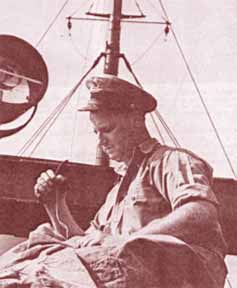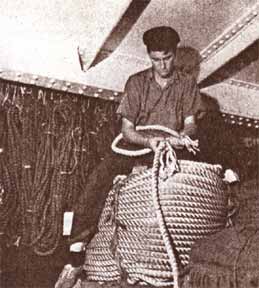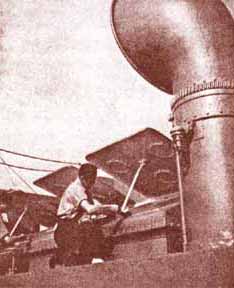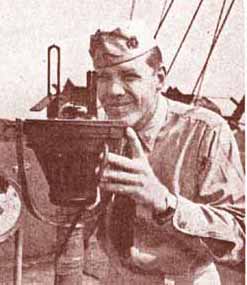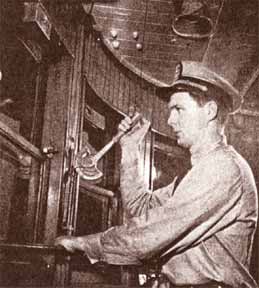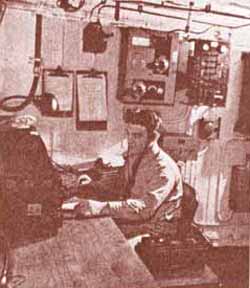Duties of Seamen in Ship's Deck Department
Officers, Bos’n, Able Seamen and Ordinary Seamen run this department
The many and varied duties of the deck department are probably the most important and interesting aboard a merchant ship. Upon those who spend their working hours topside falls a burden that ranges from chipping and scaling paint to the actual navigation of the vessel.
Merchant ships differ in size and complement, but the average ship that sails the seven seas today, bringing war material to our armies and those of our allies, generally conforms to a single pattern of manpower. The duties of those men also run true to form, more or less, but as the saying goes among seamen -- “different ship, different long splice.” All of which is translated as meaning that different ships and masters have their own way of doing things. Generally, however, they are similar.
Starting at the bottom is the Ordinary Seaman (OS) whose duties actually are to assist the able seaman. In reality, however, he is the deck utility man and may be called upon to do any one of many tasks.
The ordinary may be called upon to stand a lookout, to scale and chip paint, to paint, handle lines in the mooring of the ship, and to assist in the actual tying up and letting go of the vessel. The ordinary also assists in the handling and operation of all deck gear such as topping, cradling and housing of booms and he may also be asked to aid the carpenter in repair work.
It is likely that the ordinary may be allowed to act as helmsman, to read the draft markings or to act as cargo watch in the loading and discharging of cargo.Calling the watch (the awakening of men, including officers, who are slated to go on watch, or to so remind them if they are awake) is another of the important duties of the ordinary. He also assists in emergency drills (lifeboat, abandon ship and fire) and keeps the passageways and heads in shipshape condition on the 4 to 8 watch. He may also work aloft or over the side.
The Able Seaman (AB), by law, must be able to perform any deck duties aside from the actual navigation of the vessel. In general his duties include the ability to splice wire or fibre line, to work aloft and over the side of the ship, to operate the deck machinery such as the windlass or winches, to paint and mix paint, to know the principles of cargo stowage, to be a good wheelsman and competent lookout, to overhaul and install any running or standing rigging on the ship, and to be able to sew, repair and mend canvas.
The AB must be a competent and certified lifeboatman, able to handle a lifeboat under oars or sail. He must know lifeboat equipment and be able to assume the duties of the cox’n or man in charge of the lifeboat. It will also be the duty of the AB to maintain the bridge in a clean and shipshape condition.
Next on the way up the deck department ladder is the Bo’sn (Boatswain), senior unlicensed man on the ship. He is the direct contact between the crew and the chief mate and he may be likened to a foreman in any industrial plant.
The Bo’s’n must be an experienced seaman and is held responsible for anything and everything in the maintenance, care and protection of deck equipment and deck cargo. He also supervises the securing of the ship for sea and the loading and discharging of cargo. In addition, the Bos’n assists the chief mate in ordering the deck stores.
The duties of the ship's Carpenter (Chips) are numerous. He is likely to be called upon to perform work which, in many cases, is beyond that which the term carpenter implies ashore. In short, he is both a seaman and a mechanic.
In addition to doing temporary or permanent wood construction aboard ship with hand tools, he is responsible for the operation of the anchor windlass, seeing that hatch wedges are driven properly, that the deck cargo is properly lashed and that the hatch battens are in place and secure.
The carpenter also repairs blocks, keeps the lifeboat davits in good order, builds temporary or permanent partitions, shores or braces weakened or damaged bulkheads, rigs a collision mat, builds a soft patch in the event of bulging or collision, replaces broken rivets and he will assume command of an emergency crew to repair damage in event of a collision.
A Quartermaster is not a fixture on all vessels. On the larger ships, he is primarily a wheelsman and maintains the bridge and its equipment in shipshape order. He is conversant with signaling procedure, stands a gangway watch in port (responsible for the safety and security of the ship as well as escorting persons aboard who have business) and he is able to perform the duties of an able seaman (splicing line, reaving a halyard, etc.).
“Day men,” those who work with the Bo’s’n, are usually picked for outstanding ability. They work from 0800 to 1700 and stand no night watches. Their duties are the maintenance of the ship, which includes operating the anchor windlass, winches and other deck machinery.
Perched upon the "ready box," the Bo's'n, who directs the daily activities of seamen in the deck department performs one of his duties aboard ship -- that of sewing and mending the canvas. Splicing rope and wire are among the specific duties of the able seaman aboard a vessel. Here a seaman performs one of his specialties – splicing rope -- in the well-stocked Bo’sn’s locker. Painting is definitely on the list of duties which fell to the lot of the ordinary seaman aboard ship. Two ordinaries are painting the “fiddley,” the housing built around the smokestack. The Third Mate is the junior deck officer and normally stands the 8 to 12 watch. He is responsible for all life-saving equipment. In addition, the third mate keeps the ship’s log, follows the captain’s orders, and assists in the navigation of the vessel. In port, he will assist or supervise in the loading and discharging of cargo. His place is on the bridge with the captain while docking.
The Second Mate, usually the navigation officer, plots courses and takes celestial and terrestrial fixes. In peacetime he is the communications officer but the Naval officer in charge of the armed guard crew is rapidly assuming those duties because many of the messages now received are in secret code. The second mate also handles the after deck when tying up. He stands the 12 to 4 watch.
The First or Chief Mate is responsible for the maintenance of the ship and proper stowage of cargo. He handles the fore deck in tying up, is a good navigator, a thorough seaman, possesses the necessary qualities of leadership and will assume command of the vessel in the event of the master’s death or inability to command the ship. He stands the 4 to 8 watch.
Second Mate, the navigation officer, takes a bearing on an object with the Pelorus. He is also the communications officer but the Naval officer in charge of the gun crew assumes that duty now. Officer on watch may be the first, second or third mate. His station is up on the bridge and he commands the ship in the captain’s absence. Here he sounds the ship’s whistle during a fog. Radio Operator sends very few messages in wartime unless an emergency arises. Mostly he monitors the radio direction finder and stands a watch. Which brings us to the Captain who is lord and master of all he surveys. Actually his title is “Master.” He is in charge of everything and everyone aboard ship. He must be as closely acquainted with the steward’s department and the engine department as he is with the bridge and he must know the reason for every job performed aboard his vessel.
It should be remembered that the Master is the agent of the company which owns the ship and is not a member of the crew. He represents the company in every operation of the ship under his command. His is the full responsibility of the ship. Although he stands no watches he will always be found, in the event of foul weather or fog, on the weather side of the bridge until the danger is over, even though such foul weather lasts for 24, 48 or even 72 hours at a stretch.
In any emergency the captain will be up on the bridge conning his ship, despite the fact that he may have sunk exhausted on his bunk after a long vigil just three hours ago.
The captain also may act in the Shipping Commissioner’s capacity in signing off a crew after a coastwise trip. It is required of a master, as well as all his mates, that he have a first aid certificate and be capable of administering, if necessary, to the medical needs of the crew.
Any one of the deck officers from the Third Mate up will be in charge of any one of the lifeboats in abandoning ship.
When a ship is at sea, the watches are usually four hours on and eight hours off, but the crew may be broken out at any time in the event of an emergency. While in port, watches are usually broken. The crew works from 0800 to 1700 with an hour for chow. The ordinary or able seamen agree among themselves, as a general rule, as to which will stand the gangway watch at night.
It is important to remember that although every man in the deck department has specific duties, he must be absolutely familiar with the duties of the men who rank above him.
Source:
MAST, June 1944Duties of Seamen in Ship's Engine Department
Duties of Seamen in Stewards Department
01/29/05
www.USMM.org ©1998 - 2006. You may quote material on this web page as long as you cite American Merchant Marine at War, www.usmm.org as the source. You may not use more than a few lines without permission. If you see substantial portions of this page on the Internet or in published material please notify usmm.org @ comcast.net
